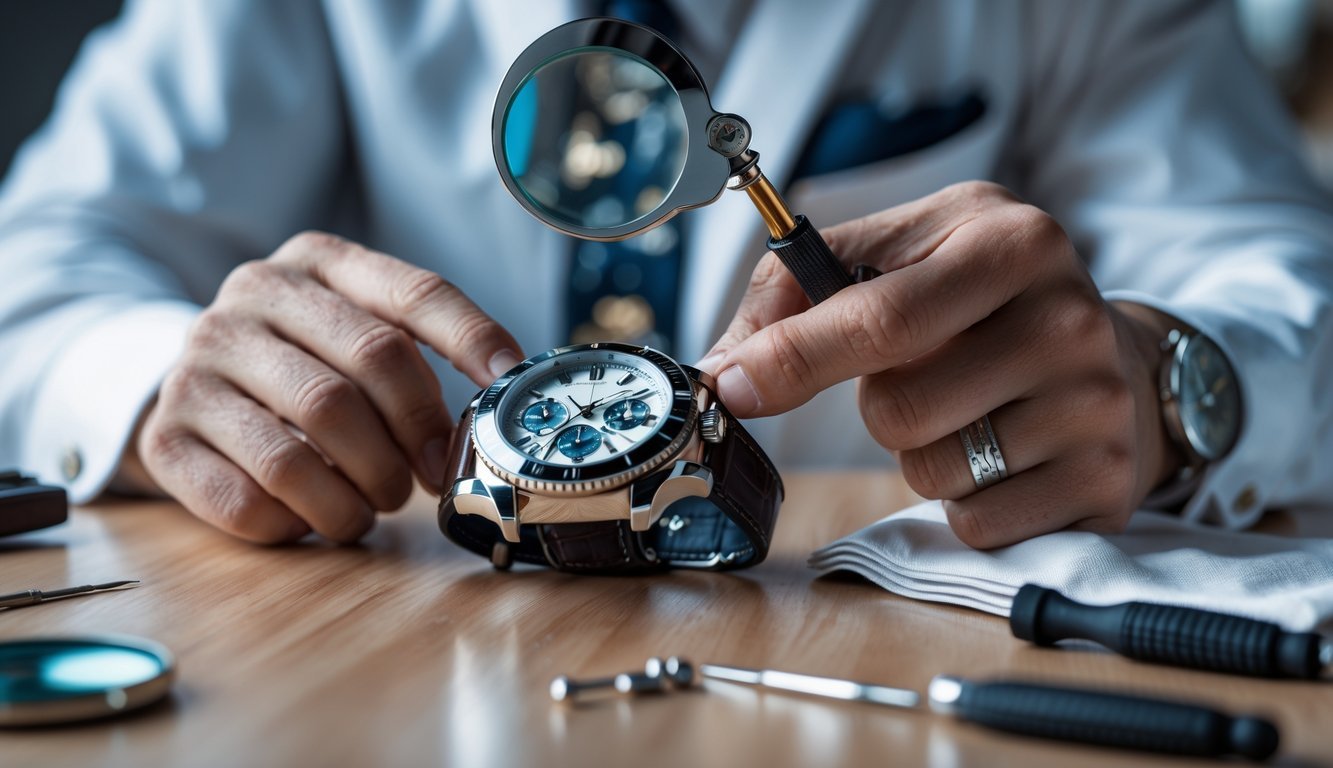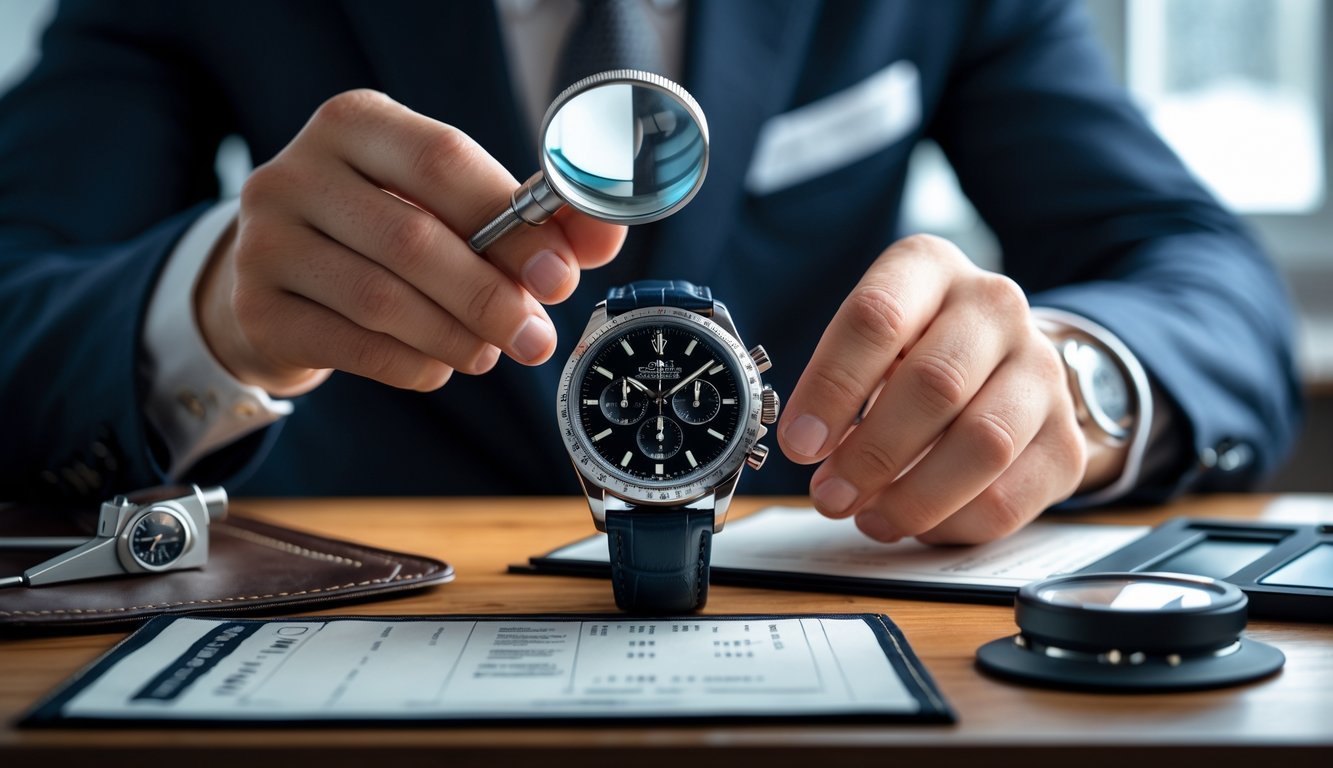Buying a luxury watch can feel risky, especially with so many fakes out there. Real luxury watches have unique features like exact serial numbers, top-notch materials, and careful craftsmanship.
You can check these by inspecting the watch and using professional authentication services.
Knowing how to verify authenticity helps protect your money and lets you buy with more confidence.
Spotting the difference between a genuine and fake luxury watch usually comes down to tiny details most people overlook.
Things like the weight, the smoothness of the movement, or even the way the finishing looks can set real watches apart from the best fakes.
These days, expert verification and modern authentication tools help buyers get the real deal.
This guide walks you through how collectors and dealers spot authentic watches.
You’ll get tips on what to check yourself—and when it’s time to call in a pro.
Key Takeaways
- Check serial numbers, materials, and craftsmanship details to verify authenticity
- Professional authentication services offer expert verification for high-value watches
- Knowing how authentication works gives you more confidence when buying
Fundamental Methods for Authenticating a Luxury Watch

Authentic luxury watches need close inspection of their parts, the right paperwork, and sometimes, digital verification.
These steps help confirm if a Rolex, Patek Philippe, or Omega is real.
Physical Inspection of Watch Components
Start by looking at the watch case and bezel.
Brands like Rolex Submariner or Omega Speedmaster use premium materials and flawless finishing.
Feel the weight of the watch in your hand.
Genuine Patek Philippe, Vacheron Constantin, and Audemars Piguet watches always have a solid, substantial feel because of their quality movements and materials.
Check the dial for sharp printing and perfect alignment.
Luxury brands obsess over text placement, font style, and logo position.
Key components to check:
- Case back engravings and serial numbers
- Crown and pushers
- Bracelet or strap quality
- Visible movement (if the case back is clear)
Take a close look at the hands and hour markers.
Real luxury watches have crisp edges and the luminous paint is applied perfectly.
Brands like Cartier pay special attention to these small details.
Evaluating Brand Documentation and Provenance
Authentic watches come with paperwork from authorized dealers, like warranty cards, certificates of authenticity, and instruction manuals.
Make sure the serial numbers are the same everywhere—in the paperwork and on the watch.
Rolex, Omega, and others keep databases that help you check these numbers.
Look into the watch’s history if you can.
The best watches have clear records of ownership and service from authorized places.
Important documents to look for:
- Original warranty card with matching serial number
- Certificate of authenticity from the brand
- Service records from authorized dealers
- Original box and accessories
Contact the manufacturer if you’re unsure about a serial number.
Many luxury watch brands will help you confirm if a watch is legit.
Authenticity Verification Using Blockchain and Digital Tools
Some brands now use blockchain technology to create digital certificates for their watches.
This helps with traceability and adds another layer of security.
Try manufacturer apps or online databases to check serial numbers.
Rolex and Omega have official tools for this on their websites.
Third-party authentication services use advanced scanning to catch details that fakes miss.
They look at stuff under magnification that’s tough to copy.
Digital verification options:
- Brand-specific mobile apps
- Blockchain certificates
- Professional authentication services
- Serial number lookups
Pro watchmakers use special tools like microscopes and timing machines.
These tools reveal real manufacturing details that fakes can’t match.
Expert Guidance and Market Considerations During Authentication
Experts bring valuable skills when it comes to authenticating luxury watches.
Knowing what’s happening in the market also helps buyers make smarter choices.
Trends and collector preferences often shape authentication methods and how people judge value.
Consulting Specialists and Trusted Marketplaces
Certified watch authenticators have the kind of experience most collectors don’t. They use advanced tools and access deep databases to check if a watch is real.
Specialists you might contact:
- Authorized dealers for your brand
- Independent certified appraisers
- Auction house experts
- Watch repair pros with brand training
These experts usually charge $100-500 for a full evaluation.
That fee can save you from spending thousands on a fake.
Trusted marketplaces enforce strict authentication rules.
Christie’s, Sotheby’s, and Antiquorum have experts on staff who check every watch.
Gold content analysis needs pro equipment.
Only trained professionals can test if the metal is real or just plated.
Online platforms like Chrono24 and WatchStation offer authentication too.
They work with certified specialists before selling watches.
Understanding the Role of Collectors and Market Trends
The luxury watch market hit $7.2 billion in 2024, according to IMARC Group.
With that kind of money at stake, counterfeiters keep getting better.
Seasoned collectors can spot fakes that trick most people.
They notice tiny differences in fonts, finishes, and other details.
Things that affect authentication:
- Popular models attract more fakes
- Vintage watches need special historical knowledge
- Limited editions require checking production records
Collectors’ forums and communities often share tips for spotting fakes.
People post about common red flags for certain models.
When prices jump, authentication becomes even more urgent.
Counterfeiters target the hottest models during those times.
During holidays, fake watches flood the market to meet gift demand.
Both real and fake watches become more common then.
Frequently Asked Questions

Authenticating a watch means checking things like serial numbers, movement details, and the seller’s credentials.
Professional services and solid verification methods help buyers avoid fakes.
What are the steps to verify the authenticity of a luxury watch?
Start by finding the serial number and checking it against the brand’s database.
The serial should be in the right spot and engraved properly—not laser-etched.
If you can, look at the movement through the caseback.
The inside should match the model and brand specs.
Look for misaligned text, weird fonts, or cheap materials.
Real luxury watches have perfect finishing and feel balanced in your hand.
Check the seller’s reputation and ask for paperwork.
Service records, warranty cards, and the original box all help.
How can one use a serial number to check a watch’s authenticity?
Find the serial number where the brand usually puts it—on the case or movement.
Each brand has its own spot for this.
Check the number against trusted databases like the Art Loss Register.
This helps you see if the watch is stolen or legit.
Make sure the serial matches the paperwork. Missing or changed serial numbers are big warning signs.
If you’re worried, contact the manufacturer.
Many luxury brands keep records and will confirm if your watch is real.
What should you look for in a reputable watch authentication service?
Go for services with clear credentials and a solid track record.
The best authenticators share info about their background and skills.
Choose services that give you detailed reports and some sort of guarantee.
They should document how they checked your watch.
Make sure they know your watch’s brand and model.
Each brand has its quirks, so specific experience matters.
Check reviews and industry reputation.
Good authentication services have lots of happy customers and solid feedback.
Is there a reliable app for verifying the authenticity of high-end watches?
Most luxury watch brands don’t have official authentication apps.
Trained professionals still do the best job.
A few apps offer reference info and serial number checks.
But these are just extra tools—not a replacement for expert eyes.
Smartphone apps can’t catch the most convincing fakes or check inside the watch.
They can’t judge movement quality or fine details.
Use apps for a quick check, but always get a pro to authenticate valuable watches before you buy.
Can authenticity of a watch be confirmed through online services, and how accurate are they?
Online authentication services range from pretty good to not-so-great.
Some use detailed photo checks and databases for real verification.
Good online services ask for lots of clear photos from different angles.
They look for details that set real watches apart from fakes.
Accuracy depends on the service’s experience and the quality of your photos.
The most convincing fakes usually need hands-on inspection.
Look into the service’s reputation before you use them. Trusted sellers have clear verification steps and fair return policies.
How do you differentiate a genuine luxury watch from a counterfeit one?
Start by picking up the watch and feeling its weight.
Real luxury watches use high-quality metals and parts, so they usually feel heavier and more balanced in your hand.
Take a close look at how the second hand moves.
On authentic luxury watches, the second hand glides smoothly, and the watch keeps time with impressive accuracy.
Pay attention to the finishing and little details.
Genuine watches show off consistent engravings, perfectly aligned markers, and flawless surfaces.
Double-check that all the components are original.
If any part looks out of place or doesn’t match the model’s specs, you might be dealing with a “Frankenwatch”—basically, a mix of parts that doesn’t belong together.


